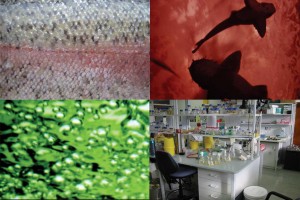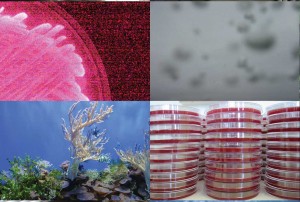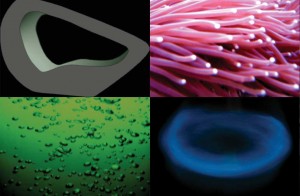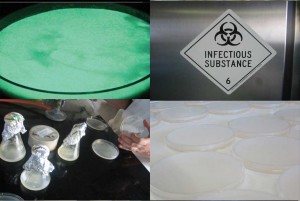A walk through any research lab can be an assault on the senses. It could be learning the structure of a particular cell or an arrangement of laboratory glassware ready for sterilisation that makes an impact on you. Having access to this facility has been a luxury. It has opened up a whole new range of materials, tools and paths of investigation.
 John Nicholson’s artistic practice is concerned with combining sculpture and technology with elements of the natural world. What began as visual representation has now moved towards a more intimate relationship with natural phenomena, in particular with living bioluminescent bacteria. This journey of research has taken place during his self-initiated Artist in Residence with the School of Biotechnology and Biomolecular Science at the University of New South Wales, Sydney.
John Nicholson’s artistic practice is concerned with combining sculpture and technology with elements of the natural world. What began as visual representation has now moved towards a more intimate relationship with natural phenomena, in particular with living bioluminescent bacteria. This journey of research has taken place during his self-initiated Artist in Residence with the School of Biotechnology and Biomolecular Science at the University of New South Wales, Sydney.
As synergies and new possibilities evolved from this collaboration, John and his key scientist, Dr Kathy Takayama formed the Symbiotic Bacterial Light Project (SBLP) to ‘research and develop the functional capabilites of the natural process of bioluminescence with respect to its creative application towards visual media and interactive technology’.
 Bioluminescence is the organic light form that is emitted from living bacteria. His work explores new environments that can sustain large volumes of the living-cultured bacteria. These constructions create environments which expose this emitted light and suggest a future lifestyle that contains this alternative energy source.
Bioluminescence is the organic light form that is emitted from living bacteria. His work explores new environments that can sustain large volumes of the living-cultured bacteria. These constructions create environments which expose this emitted light and suggest a future lifestyle that contains this alternative energy source.
We expect to transpose the essence of bacterial communication, manifested as a light source, onto the experience of the audience, who will usurp this biological phenomena, allowing audiences to explore these spaces of intimacy with nature.
Microbes outnumber all other living things; they inhabit every imaginable environment and control the biological, geological and chemical cycles that shape the planet and make life possible. Their growth and replication are important for biological characterisations and experimentation. SBLP aims to remove these organisms from their perfunctory roles and pursue new paths of investigation to highlight microbial function in terms of a social context.
 John asks the question, ‘is nature becoming merely a plaything within our techno-centric culture?’ Are we harnessing this natural source of power for our own benefit? Bacteria, and their place in the world in which humans are just another inhabitant, signifies our lack of awareness of the natural phenomena that surrounds and outnumbers us. Discussions on the human ability to edit and manipulate our world appear to overlook the role and power of our planet mates.’
John asks the question, ‘is nature becoming merely a plaything within our techno-centric culture?’ Are we harnessing this natural source of power for our own benefit? Bacteria, and their place in the world in which humans are just another inhabitant, signifies our lack of awareness of the natural phenomena that surrounds and outnumbers us. Discussions on the human ability to edit and manipulate our world appear to overlook the role and power of our planet mates.’
John’s new work, LuxCorp, will give audiences the opportunity to experinece and communicate with this living light source and explore our emotional responses to these notions. This installation combines a large scale sculpture containing a series of bioluminescent light sources with apparatus of a scientific laboratory; namely a generator which provides a suitable and sustainable environment for the reproduction of the required bacterial organisms.
 At the centre of the gallery is what at first appears to be two large glowing chambers. As the spectator approaches, the sculpture takes on the form of domestic furniture. The visitor is invited to recline in the semi enclosed chaise lounge and is free to experience the reproduction of bacteria.
At the centre of the gallery is what at first appears to be two large glowing chambers. As the spectator approaches, the sculpture takes on the form of domestic furniture. The visitor is invited to recline in the semi enclosed chaise lounge and is free to experience the reproduction of bacteria.
The gallery space is bathed in a light emanating from the sculpture. Taking cue from sci-fi films like ‘Alien’, the space takes on a subtle sinister edge. The space is a representation of a corporate biotech showroom displaying its latest line of prototypes. Will the audience be concerned about their own safety?
This new work will be showing at the Canberra Contemporary Art space as part of Metis Science and Art Festival commencing in May 2004.
Linda Cooper
 This work is licensed under a Creative Commons Attribution-NonCommercial-ShareAlike 3.0 Australia.
This work is licensed under a Creative Commons Attribution-NonCommercial-ShareAlike 3.0 Australia.






